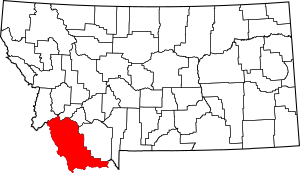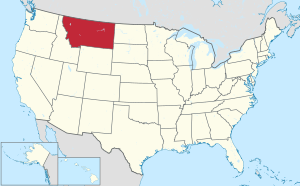Beaverhead County, Montana facts for kids
Quick facts for kids
Beaverhead County
|
|
|---|---|

Beaverhead County Courthouse
|
|

Location within the U.S. state of Montana
|
|
 Montana's location within the U.S. |
|
| Country | |
| State | |
| Founded | 1865 |
| Seat | Dillon |
| Largest city | Dillon |
| Area | |
| • Total | 5,572 sq mi (14,430 km2) |
| • Land | 5,542 sq mi (14,350 km2) |
| • Water | 30 sq mi (80 km2) 0.5% |
| Population
(2020)
|
|
| • Total | 9,371 |
| • Estimate
(2022)
|
9,719 |
| • Density | 1.68180/sq mi (0.64935/km2) |
| Time zone | UTC−7 (Mountain) |
| • Summer (DST) | UTC−6 (MDT) |
| Congressional district | 1st |
|
|
Beaverhead County is the biggest county in Montana, a state in the United States. In 2020, about 9,371 people lived there. The main town, or county seat, is Dillon. This county was started in 1865.
A big part of the county's edge follows the Continental Divide. This is like a giant mountain ridge that separates rivers flowing to the Pacific Ocean from those flowing to the Atlantic. It forms the whole border with Idaho.
Contents
History of Beaverhead County
The county got its name from a cool rock shape that looked like a beaver's head. The Shoshone Native Americans described this unique rock formation.
The first county seat was a gold-mining town called Bannack. But in 1881, the county seat was moved to Dillon, where it is today.
Geography and Nature
Beaverhead County is huge! It covers about 5,572 square miles. Most of this area is land, with a small part being water. It's the largest county in all of Montana.
You can find the Beaverhead impact structure here, which is a place where a very old meteor likely hit the Earth. The Big Hole River also flows through the county, offering beautiful scenery.
Neighboring Counties
Beaverhead County shares borders with several other counties:
- Ravalli County (to the northwest)
- Deer Lodge County (to the north)
- Silver Bow County (to the north)
- Madison County (to the east)
- Fremont County, Idaho (to the southeast)
- Clark County, Idaho (to the south)
- Lemhi County, Idaho (to the west)
Main Roads in Beaverhead County
Important roads that help people travel through the county include:

 I-15 / US 91
I-15 / US 91 MT 41
MT 41 MT 43
MT 43
Protected Natural Areas
Several special natural areas are found partly or entirely within Beaverhead County:
- Beaverhead National Forest (a large forest area)
- Big Hole National Battlefield (a historic site)
- Nez Perce National Historical Park (part of a park that tells the story of the Nez Perce people)
- Red Rock Lakes National Wildlife Refuge (a safe home for wildlife)
People of Beaverhead County
| Historical population | |||
|---|---|---|---|
| Census | Pop. | %± | |
| 1870 | 722 | — | |
| 1880 | 2,712 | 275.6% | |
| 1890 | 4,655 | 71.6% | |
| 1900 | 5,615 | 20.6% | |
| 1910 | 6,446 | 14.8% | |
| 1920 | 7,369 | 14.3% | |
| 1930 | 6,654 | −9.7% | |
| 1940 | 6,943 | 4.3% | |
| 1950 | 6,671 | −3.9% | |
| 1960 | 7,194 | 7.8% | |
| 1970 | 8,187 | 13.8% | |
| 1980 | 8,186 | 0.0% | |
| 1990 | 8,424 | 2.9% | |
| 2000 | 9,202 | 9.2% | |
| 2010 | 9,246 | 0.5% | |
| 2020 | 9,371 | 1.4% | |
| 2022 (est.) | 9,719 | 5.1% | |
| U.S. Decennial Census 1790–1960, 1900–1990, 1990–2000, 2010–2020 |
|||
In 2020, the county had 9,371 people living there. Most people in Beaverhead County are white. About 1.4% are Native American. People of Hispanic or Latino origin make up about 3.7% of the population.
The average age of people in the county is about 42 years old. Many families live here, and the average household has about two people.
Economy and Jobs
Beaverhead County is well-known for its large cattle ranches and for growing hay. It's one of the biggest areas in Montana for these activities.
The county is also home to Barrett's Minerals, which is one of the world's largest mines for talc. Talc is a soft mineral used in many products, like cosmetics and paper. Barrett Hospital and Healthcare is a major employer in the county, providing many jobs.
Education in Beaverhead County
For higher education, the University of Montana Western is located in Dillon. This university offers various study programs for students.
Towns and Communities
City
- Dillon (This is the county seat, the main town where the county government is located.)
Town
Smaller Communities
There are also several smaller communities, often called census-designated places, which are not officially cities or towns but have groups of homes and people:
Other Small Places
You can also find other small, unincorporated communities in the county:
Past Communities
Some communities that used to exist in Beaverhead County are no longer there:
- Armstead - This town was flooded when the Clark County Reservoir was built in 1964.
- Bannack - This was the first county seat and is now a National Historic Monument and Bannack State Park. You can visit it today!
- Hecla
- Lion City
Famous People from Beaverhead County
- Joseph Poindexter was a lawyer in Beaverhead County before he became the Territorial Governor of Hawaii.
- Thomas Savage (1915-2003) was a writer who spent his childhood and teenage years on his family's ranch in Beaverhead County. His experiences there inspired some of his most famous books, like The Power of the Dog.
See also
 In Spanish: Condado de Beaverhead para niños
In Spanish: Condado de Beaverhead para niños

